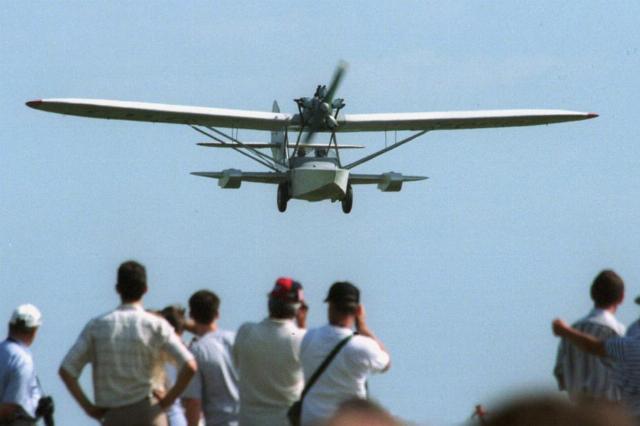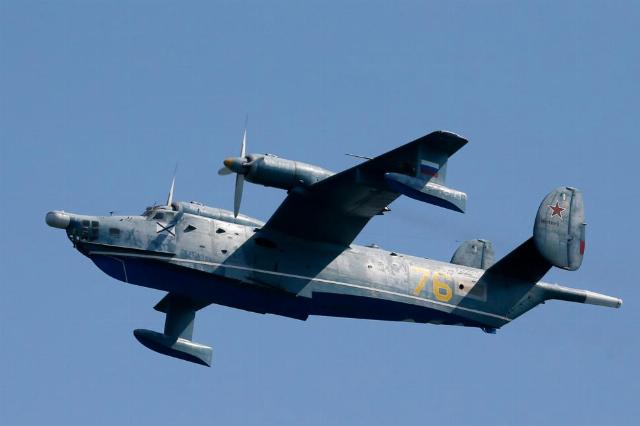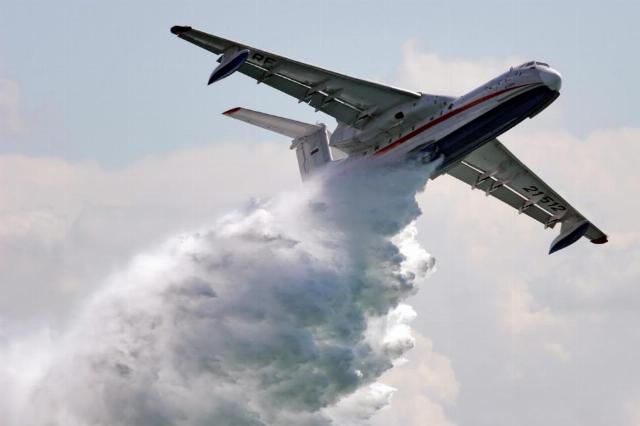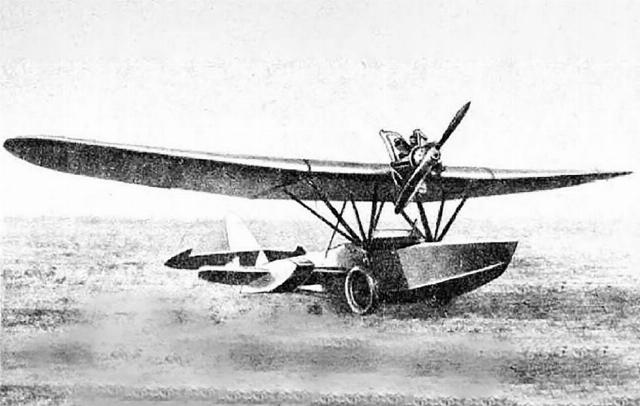Russia is washed by the waters of 12 seas, over 2.5 million rivers and more than 2.7 million lakes on its territory. The length of the country's water border is twice the length of the land border and is almost 40 thousand km. In these conditions, aircraft capable of using both land lanes and water surfaces as airfields have great advantages. Seaplanes, taking off and landing on the water, began to be created after the first land-based airplanes. For example, Alexander Prokofiev-Seversky fought on the "flying boat", who later became the first military pilot to fly with a prosthetic limb.
The first domestic amphibious aircraft, the Gakkel V, was developed by Yakov Gakkel in 1911, but it did not come to testing. But the first successfully flown "two-medium" aircraft was the Sh-1 of aircraft designer Vadim Shavrov. Shavrov built a three-seat "flying boat" with a raised wheeled chassis independently and with the help of his closest colleagues. Later, Shavrov himself recalled in the book "The History of aircraft designs in the USSR before 1938" that the wooden elements of the body and wing of the aircraft were made in the apartment of engineer Viktor Korvin, and the final assembly of the device was carried out at the airfield in Leningrad. After taxiing on the water, the first flight took place, and on August 6, 1929, the Sh-1 flew for the first time as an amphibian: taking off from the water, landed on land. Already in August, the plane flew to Moscow to the Central Airfield on Khodynka field.
Plywood polar worker Sh-2
The first Soviet serial amphibious aircraft was the Sh-2, a "flying boat" with a wheeled landing gear and a folding wing, a development of the Shavrov solutions used in the Sh-1. The design of the three—seater aircraft was made of wood, the parts were connected with casein glue and nails, the body was sheathed with plywood, the wing was fabric with moisture-resistant impregnation. Only the central part of the wing, on which the 100-horsepower engine was located, was made of metal. If necessary, the wheeled chassis could be changed to a ski chassis. The fuel supply was enough for 11 hours of flight.

Sh-2 aircraft
Image source: © Alexey Panov/ TASS
The aircraft has been produced since 1932, in total several hundred cars were built. Today, one of the few surviving copies of the Sh-2 is kept in the Museum of the Arctic and Antarctic in St. Petersburg. The wooden airplane with an open cockpit was successfully operated in the harsh conditions of the northern seas.
"It was a versatile aircraft, a real hard worker," said Mikhail Lamakin, Deputy Director of the museum for Scientific Work. "It was used all over the country, but for us the most important thing is its work in the Arctic: ice exploration, postal service, sanitation — a real workhorse."
The museum's "shavrushka" — as the plane was affectionately called — has numerous dents on the wings. Museum staff believe that this is exactly the car that was on board the Chelyuskin steamer and took part in the rescue of its crew. The aircraft was damaged during unloading on drifting ice, which clamped the steamer. Pilot Mikhail Babushkin and a mechanic managed to repair the amphibian and fly it from the ice camp to the village of Vankarem. Babushkin performed ice reconnaissance on Sh-2, coordinated the operation to take Chelyuskin residents to the mainland.
Sh-2s have served the country for more than three decades — they flew in the North, Siberia and the Far East, they were used in geological exploration expeditions, in forestry, as a liaison aircraft. In the pre-war years, Vadim Shavrov created several more multi—seat amphibious aircraft — this time with closed cabins - but they did not go into production. For example, the Sh-7, built (according to open data) in a single copy and designed to work in high latitudes, during the Great Patriotic War it transported important goods on the Volga.
The Be-12 Submarine Hunter
The Be-12 Chaika— an aircraft considered a legend of Russian naval aviation, was created as a specialized means of combating submarines in the 1950s, during the emergence and development of nuclear submarines. The task for the construction of the aircraft was received in 1956 by the Georgy Beriev Design Bureau (now the Taganrog Aviation Scientific and Technical Complex named after G.M. Beriev as part of the United Aircraft Corporation (UAC) Rostec). Previously, aircraft designed to search for submarines carried a bomb load and small arms on board. However, in the early 1950s, Russian engineers developed the first radio hydroacoustic system for aircraft. It consisted of special buoys dumped into the water and an on-board receiving device. Once in the water, the buoy was activated and began searching for submarines using its sonar station, transmitting the received data to the anti-submarine aircraft over the radio channel. In addition, an aviation magnetometer has appeared — a device capable of detecting a submarine by distorting the Earth's magnetic field to it.

Be-12 "Chaika"
Image source: © Ekaterina Shtukina/ POOL/ tass
Such a complex for searching for submarines, as well as their means of destruction, was to be carried on board a new turboprop amphibious aircraft. The Be-12 made its first flight in the autumn of 1960, and the "flying boat" rose from the unpaved factory airfield in Taganrog. The aircraft is packed with search equipment and weapons, and more than 20 variants of its combination are allowed: anti-submarine bombs (including nuclear ones), torpedoes, mines, radio hydroacoustic buoys of various types. The aircraft can be loaded as a search and carry 90 buoys, search and strike (36 buoys and 1 torpedo), shock (3 torpedoes) - up to 3 tons of combat load in the reloading version. To detect submarines, the Be-12 carries a radio hydroacoustic system, an aviation search magnetometer, and a radar station is installed in the bow — the removal of its antenna gives the car a characteristic "duck" appearance.
The design of the flying submarine chaser took into account the specifics of its work. The wing received a characteristic fracture — a "seagull" — in the central part in order to lift two engines higher from the water surface. The aft part of the boat is made non-magnetic, so as not to interfere with the operation of the magnetometer mounted on a three-meter rod. The entrance hatches open in a ship-like manner, making it easier to leave the aircraft in case of flooding, and the boat was divided into compartments with hermetically sealed hatches. The Be-12, like a ship, has a bottom anchor with a winch and a water rudder — with its help, the pilot maintains the direction when moving on the water.
"Flying boats" patrolled the sea and ocean waters hundreds of kilometers from the coast of the country, detecting foreign submarines visually and with the help of instruments. The longest tracking of a submarine in the history of anti-submarine aviation took place in August 1974 in the Barents Sea. At that time, naval aircraft and helicopters conducted an unknown target for almost 60 hours, setting up buoys and transmitting the coordinates of the target to the search and strike group.
The turboprop amphibious aircraft was mass-produced from 1963 to 1973, in total about 140 copies were produced. The car holds almost 60 world aviation records for height and payload in its class.
VVA-14 vertical take-off amphibian
In the 1960s, the confrontation between the nuclear superpowers — the USSR and the United States — reached a new level. In 1962, the Caribbean crisis broke out, the countries are teetering on the brink of nuclear conflict. The probable enemy of the Soviet Union is armed with nuclear submarines with ballistic missiles. To counter the submarine fleet, a talented Soviet designer of Italian origin Robert Bartini proposes a project for an anti-submarine amphibious aircraft capable of taking off and landing vertically.
The project, approved by the Ministry of Defense, was named VVA-14. In 1972, a prototype aircraft made its first flight. According to data from open sources, the aircraft was supposed to be equipped with two mainline turbojet engines and 12 lifting engines for vertical takeoff and landing. The design take-off weight of the aircraft was 52 tons, of which up to 4 tons were in service. It was assumed that the unique amphibian would be able to carry various torpedoes and bombs, including those with a nuclear warhead, and a large number of sonar buoys. Interference sources were provided for self-defense. To reduce aerodynamic drag, Bartini proposed to equip the aircraft with retractable pneumatic take-off and landing devices. To save the crew in the event of an accident, the designer came up with a detachable cabin.
Despite the trials that began, the project with a huge number of innovative solutions was not completed, and after Bartini passed away in 1974, it was completely curtailed. Today, one of the VVA-14 prototypes built is located on the territory of the Central Air Force Museum in Monino.
Be-200 reactive thunderstorm of forest fires
Beriev Design Bureau began work on an amphibious aircraft equipped with turbojet engines in the mid-1950s. As a result, the world's first mass-produced jet "flying boat" Be-10 appeared.

Be-200
Image source: © Marina Lystseva/ TASS
In the 1980s, the design bureau created the world's largest amphibious aircraft, the A-40 Albatross. The creators took out two of its jet engines high above the wing and fuselage. In 1992, the Russian government decided to develop multi-purpose amphibious vehicles for the transportation of passengers and cargo, rescue operations and fire fighting. As a result, the Be-200 appeared, called the best in its class.
"The Be-200 laid the foundation for all the ideas, the best ideas that were achieved during the construction and testing of the previous amphibious aircraft A-40, which had no analogues in the world," recalled Gennady Panatov, General designer of the Be-200. "But it was important to understand where to build this aircraft. After all, in the 90s, and the government decree on the construction of the aircraft was issued in 1992, there was devastation, no one had the financial resources to start building experimental aircraft, and then mass production," he added. However, according to the memoirs of the designer, such opportunities were available to the Irkutsk Aviation Production Association (now the Irkutsk Aviation Plant, a branch of PJSC Yakovlev UAC), which built Sukhoi aircraft (including for export). It was decided to produce the Be-200 on its basis.
The Be-200 is the world's only amphibious jet aircraft, a unique aircraft for extinguishing forest fires. It is capable of taking off and landing at wave heights up to 1.2 m, carrying up to 12 tons of water, taking it directly from the surface of the reservoir in motion, in a planing mode, and then bringing it down on the source of ignition. Thus, in one refueling, the aircraft is able to deliver up to 270 tons of water. The maximum take-off weight of the Be-200 on land is 42 tons, the aircraft accelerates to 700 km/h.
In 2010, a unique amphibian successfully withstood the ash test of an Icelandic volcano eruption, which passenger airliners are afraid of. The Be-200ChS fought fires not only in Russia, but also in Greece, Israel, Indonesia, Italy, Portugal, Serbia, Turkey, and France.
Initially, the aircraft was created in cooperation with foreign partners. Today, the process of import substitution is underway — for example, the engines are supposed to be replaced with the latest Russian PD-8, created using the most modern technologies.
Victor Bodrov
The materials of V.B. Shavrov's books in the series "The History of aircraft designs in the USSR" were used

